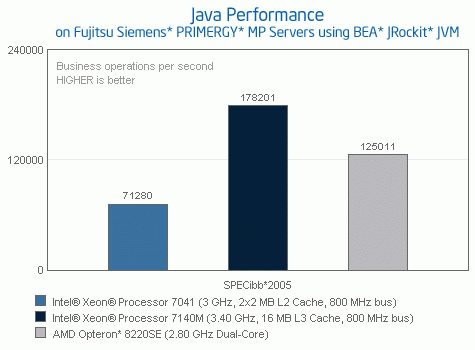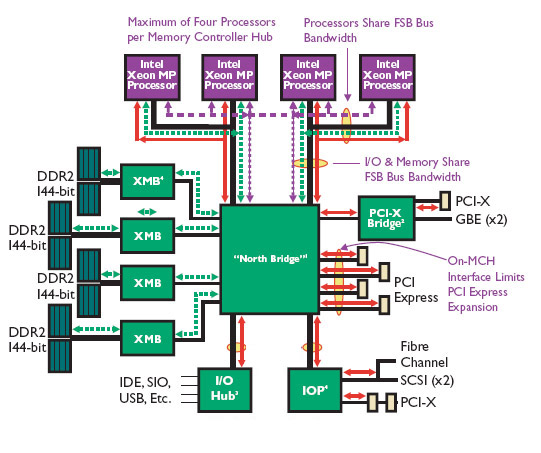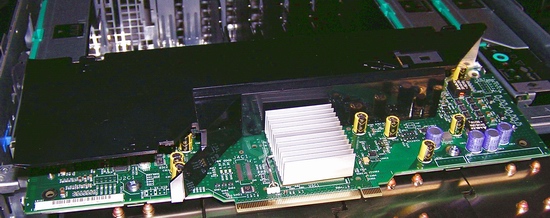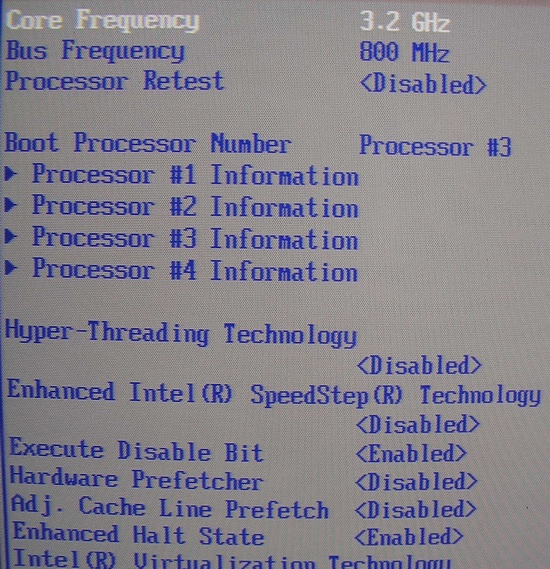Intel's newest Quad Xeon MP versus HP's DL585 Quad Opteron
by Johan De Gelas on November 10, 2006 12:00 PM EST- Posted in
- IT Computing
The Xeon 70xx
Tulsa or the Xeon MP 71xx is the last Mohican of the "NetBurst / Pentium 4" tribe. It is the successor of the Xeon MP 70xx, also known as the infamous Paxville CPU. The Xeon MP 70xx was one of the worst CPUs in history from a performance/Watt view. The max TDP of Paxville was no les than 173W, and the CPU was limited to "only" 3 GHz, which is low for a NetBurst CPU as NetBurst CPUs were initially built for 4 GHz and more. According to Intel's own graphs, the fastest Opteron beats the best Xeon MP 7041 by no less than 30% in integer benchmarks....

... and by no less than 76% in Java Server benchmarks!

Needles to say, the Xeon 70xx is and was a small disaster and one of the reasons why AMD's Opteron gained so much support so quickly. With that kind of heritage, the expectations for the Xeon MP 71xx, aka Tulsa, are not high. Is Tulsa yet another power gobbling CPU which can't outperform the competition? Although the CPU is sitting completely in the shadow of Intel's newest Core based Xeons, Intel engineering did spend a lot of time on trying to make the last NetBurst CPU perform well and consume less.
Tulsa is a dual core Xeon built on Intel's very successful 65 nm process. It is a true dual core, with both cores sharing some control logic and a large L3 cache which can be 4, 8 or 16 MB in size. Tulsa can scale up to 3.4 GHz, but we tested the more affordable 3.2 GHz version with 8 MB cache.

The Tulsa Die
The biggest Tulsa die weighs in at 435 mm², a result of containing 1.3 Billion transistors. By using slower but 3 times less "leaky" transistors, and letting the parts of the caches that are not accessed "sleep", the caches consume less than 1 W/MB. Tulsa can be used as an upgrade for Paxville and uses the same "Truland platform" with the Twin Castle chipset. If that sounds like gibberish, the Truland platform has been tested and explained here at AnandTech by Jason.

Two independent 800 MHz FSBs give each of the 2 sockets (4 cores) a 6.4GB/s pipe to the Northbridge. By using four XMBs (eXternal Memory Bridge), capacity and bandwidth is maximized. The XMBs find a place on a hot swappable memory board, and each XMB drives 4 memory slots. Below you can see the memory board; the XMB is under the heatsink.

The big performance booster is Tulsa's L3 cache. Tulsa's massive L3 is protected by Pellston technology. As caches get bigger, the possibility of getting a data error also increases. Pellston can disable a faulty cache line (128 byte) during BIOS initialization when all cache lines are checked, or it can even do so while the CPU is processing. The Pellston technology is in fact an algorithm that checks if a cache line error is the result of a hard error or a soft error. The actual "checking" whether a cache line is bad or not is done by an ECC algorithm on the 32 ECC bits which protects the L3 cache lines. In other words, Pellston makes the ECC protect cache a little smarter, allowing it to act on ECC errors rather than only reporting ECC errors.
The L3 cache is inclusive: it also contains the contents of the L2-cache. Thanks to the shared and inclusive nature of the L3-cache coherency traffic between the four CPUs is significantly reduced. Too much Coherency traffic can cause multithreaded applications that share variables among the different threads like OLTP databases and web servers to slow down.
So higher clock speeds, the newer 65 nm process, much less leaky transistors, and an extra shared L3 should allow the Xeon 71xx "Tulsa" to perform much better than the Xeon 70xx "Paxville" and consume a quite a bit less. Considering that Xeon 71xx has a TDP of 95W at 3 GHz while the Xeon 70xx needed 165 W at the same speed, it appears that Intel engineers have been very successful in reducing power consumption.

Intel's own benchmarks indicate 42% higher Integer throughput while the clock speed has increased by 13%. The most spectacular graph is the SPECjbb one: according to Intel, the Xeon 7140 is no less than 2.5 times faster than the old Xeon 7041. However, the benchmark is rather vague, as Intel does not reveal if the JVMs were completely the same. A different JVM can make a big difference. Tulsa also supports EM64T, the XD bit, HW Virtualization Technology and EIST as you can see from our BIOS setup screenshot.
Tulsa or the Xeon MP 71xx is the last Mohican of the "NetBurst / Pentium 4" tribe. It is the successor of the Xeon MP 70xx, also known as the infamous Paxville CPU. The Xeon MP 70xx was one of the worst CPUs in history from a performance/Watt view. The max TDP of Paxville was no les than 173W, and the CPU was limited to "only" 3 GHz, which is low for a NetBurst CPU as NetBurst CPUs were initially built for 4 GHz and more. According to Intel's own graphs, the fastest Opteron beats the best Xeon MP 7041 by no less than 30% in integer benchmarks....

... and by no less than 76% in Java Server benchmarks!

Needles to say, the Xeon 70xx is and was a small disaster and one of the reasons why AMD's Opteron gained so much support so quickly. With that kind of heritage, the expectations for the Xeon MP 71xx, aka Tulsa, are not high. Is Tulsa yet another power gobbling CPU which can't outperform the competition? Although the CPU is sitting completely in the shadow of Intel's newest Core based Xeons, Intel engineering did spend a lot of time on trying to make the last NetBurst CPU perform well and consume less.
Tulsa is a dual core Xeon built on Intel's very successful 65 nm process. It is a true dual core, with both cores sharing some control logic and a large L3 cache which can be 4, 8 or 16 MB in size. Tulsa can scale up to 3.4 GHz, but we tested the more affordable 3.2 GHz version with 8 MB cache.

The Tulsa Die
The biggest Tulsa die weighs in at 435 mm², a result of containing 1.3 Billion transistors. By using slower but 3 times less "leaky" transistors, and letting the parts of the caches that are not accessed "sleep", the caches consume less than 1 W/MB. Tulsa can be used as an upgrade for Paxville and uses the same "Truland platform" with the Twin Castle chipset. If that sounds like gibberish, the Truland platform has been tested and explained here at AnandTech by Jason.

Two independent 800 MHz FSBs give each of the 2 sockets (4 cores) a 6.4GB/s pipe to the Northbridge. By using four XMBs (eXternal Memory Bridge), capacity and bandwidth is maximized. The XMBs find a place on a hot swappable memory board, and each XMB drives 4 memory slots. Below you can see the memory board; the XMB is under the heatsink.

The big performance booster is Tulsa's L3 cache. Tulsa's massive L3 is protected by Pellston technology. As caches get bigger, the possibility of getting a data error also increases. Pellston can disable a faulty cache line (128 byte) during BIOS initialization when all cache lines are checked, or it can even do so while the CPU is processing. The Pellston technology is in fact an algorithm that checks if a cache line error is the result of a hard error or a soft error. The actual "checking" whether a cache line is bad or not is done by an ECC algorithm on the 32 ECC bits which protects the L3 cache lines. In other words, Pellston makes the ECC protect cache a little smarter, allowing it to act on ECC errors rather than only reporting ECC errors.
The L3 cache is inclusive: it also contains the contents of the L2-cache. Thanks to the shared and inclusive nature of the L3-cache coherency traffic between the four CPUs is significantly reduced. Too much Coherency traffic can cause multithreaded applications that share variables among the different threads like OLTP databases and web servers to slow down.
So higher clock speeds, the newer 65 nm process, much less leaky transistors, and an extra shared L3 should allow the Xeon 71xx "Tulsa" to perform much better than the Xeon 70xx "Paxville" and consume a quite a bit less. Considering that Xeon 71xx has a TDP of 95W at 3 GHz while the Xeon 70xx needed 165 W at the same speed, it appears that Intel engineers have been very successful in reducing power consumption.

Intel's own benchmarks indicate 42% higher Integer throughput while the clock speed has increased by 13%. The most spectacular graph is the SPECjbb one: according to Intel, the Xeon 7140 is no less than 2.5 times faster than the old Xeon 7041. However, the benchmark is rather vague, as Intel does not reveal if the JVMs were completely the same. A different JVM can make a big difference. Tulsa also supports EM64T, the XD bit, HW Virtualization Technology and EIST as you can see from our BIOS setup screenshot.










88 Comments
View All Comments
Niv KA - Saturday, November 11, 2006 - link
I belive Clovertown is going to be announced somethime in the next week or two. On thursday I went to the "Microsoft: Ready for a New Day" here in Belgium (where Bill gates made an appearance of about half an hour, although not related!) and at the Intel booth they were showing off 4 servers which where running an "unannounced platform"! One of the technical guys at the booth let me in on a little "secret"! The Supermicro Systems were running "two sockets each box, each socket 4 cores! Eight cores each box! And the best part is its woodcrest arch!". I asked him if it was clovertown and he sayed that he "is just a technical assistant, not alowed to say anything" but he made the answer clear on his face! Clovertown is ready to go, and its FAST! They were running benchmarks all the time! I will post pictures on the fourms if I have enough time, but I have a HUGE project I need to hand in by tuesday so I might forget!
---Niv K Aharonovich
PS: About the "outdated" system comments above, I am fully on Anandtechs side, it is impossible for an online newspaper company to make enough money to BUY everything, esp. in the $15,000 area! The only way is to ask for it from the vendors, and the vendors decide what to provide! Good job anandtech and continue the good work!!!!!!!
Dennis Travis - Saturday, November 11, 2006 - link
Great job as usuall. Keep up the excellent work.AnandThenMan - Friday, November 10, 2006 - link
Another bullshit "comparison" nice job guys. You are comparing an AMD system that has been out for over 2 years. Useless review as usual. Why are you not comparing new with new? Why don't you use a Xeon box that was out 2 years ago?Anandtech's reviews have become more and more worthless.
JohanAnandtech - Saturday, November 11, 2006 - link
1. AMD has confirmed that they feel the HP DL585 with 4x 880 is a worthy competitor for our Tulsa machine.2. This server is 5 months old, not 2 years. As I made clear in the article, this is the 2006 revision.
As we invest a lot of time of effort to convince OEMs and others to send us extremely expensive hardware for review, spend weeks tweaking benchmarks and OS to give you benchmarks, we hope we may expect some useful feedback from our readers.
Just writing "useless" with little or no explanation why you feel it is worthless is not helping anyone.
AnandThenMan - Sunday, November 12, 2006 - link
I was going to post an explanation as to why the "review" is very poorly done. But Scientia over at AMDz did a far better explanation then I could come up with.http://www.amdzone.com/index.php?name=PNphpBB2&...">http://www.amdzone.com/index.php?name=PNphpBB2&...
Either the review is intentionally authored to show Intel in as best light as possible, or the author is incompetent and should not be doing reviews at all. I stand by what I originally posted, the review is bullshit.
primer - Saturday, November 11, 2006 - link
Agreed.goldfish2 - Friday, November 10, 2006 - link
Can I just quickly mention how nice it is to read an article where the author has managed to present all the relevant informatiom in as concise a manner as is possible, good job.JohanAnandtech - Saturday, November 11, 2006 - link
Thanks!Server reviews are extremely time consuming so most publications are not interested in it, so I am glad AT allows me to do this kind of reviews.
AllYourBaseAreBelong2Us - Friday, November 10, 2006 - link
Can you guys get a new DL585 G2 and do benchmarks with this new model instead?Viditor - Friday, November 10, 2006 - link
I thought this too...the G2 has 7 PCIe slots (3 x8, 4 x4), is $800 less expensive, and offers newer SCSI controllers.